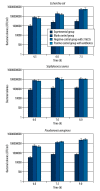The in vitro biological properties of Mg-Zn-Sr alloy and superiority for preparation of biodegradable intestinal anastomosis rings
- PMID: 24957079
- PMCID: PMC4072564
- DOI: 10.12659/msm.890638
The in vitro biological properties of Mg-Zn-Sr alloy and superiority for preparation of biodegradable intestinal anastomosis rings
Abstract
Background: Magnesium (Mg) alloy is a metal-based biodegradable material that has received increasing attention in the field of clinical surgery, but it is currently seldom used in intestinal anastomosis. This study was conducted to comprehensively assess a ternary magnesium (Mg)-zinc (Zn)-strontium (Sr) alloy's biological superiorities as a preparation material for intestinal anastomosis ring.
Material and methods: Mouse L-929 fibroblasts were cultured with Mg-Zn-Sr alloy extract and compared with both positive (0.64% phenol) and negative (original broth culture) controls. The cell morphology of different groups was examined using microscopy, and a cytotoxicity assessment was performed. Fresh anticoagulated human blood was mixed with Mg-Zn-Sr alloy extract and compared with both positive (distilled water) and negative (normal saline) controls. The absorbance of each sample at 570 nm was used to calculate the Mg-Zn-Sr alloy hemolysis ratio in order to test the Mg alloy's blood compatibility. Bacterial cultures of Escherichia coli, Pseudomonas aeruginosa, and Staphylococcus aureus were added to Mg-Zn-Sr alloy block samples and compared with positive (Ceftazidime), negative (316LSS stainless steel), and blank controls. The broth cultures were sampled to compare their bacterial colony counts so as to evaluate the antibacterial properties of the Mg-Zn-Sr alloy. The Mg-Zn-Sr alloy was surface-coated with a layer of poly(lactic-co-glycolic acid) carrying everolimus. The surface morphology and degradability of the coating were examined so as to demonstrate feasibility of coating, which can release the drug evenly.
Results: The experiments proved that Mg-Zn-Sr alloy has good biocompatible, antibacterial, and drug-loaded coating performances, which are lacking in existing intestinal anastomosis devices/materials.
Conclusions: The Mg-Zn-Sr alloy increases biocompatibility, and yields a safer and better therapeutic effect; therefore, it is a novel biomaterial that is feasible for use when preparing biodegradable intestinal anastomosis rings.
Figures








Similar articles
-
Corrosion resistance and antibacterial activity of zinc-loaded montmorillonite coatings on biodegradable magnesium alloy AZ31.Acta Biomater. 2019 Oct 15;98:196-214. doi: 10.1016/j.actbio.2019.05.069. Epub 2019 May 31. Acta Biomater. 2019. PMID: 31154057
-
The design, development, and in vivo performance of intestinal anastomosis ring fabricated by magnesium‑zinc‑strontium alloy.Mater Sci Eng C Mater Biol Appl. 2020 Jan;106:110158. doi: 10.1016/j.msec.2019.110158. Epub 2019 Sep 3. Mater Sci Eng C Mater Biol Appl. 2020. PMID: 31753379
-
A biodegradable Zn-1Cu-0.1Ti alloy with antibacterial properties for orthopedic applications.Acta Biomater. 2020 Apr 1;106:410-427. doi: 10.1016/j.actbio.2020.02.017. Epub 2020 Feb 14. Acta Biomater. 2020. PMID: 32068137
-
Study on the Bioactivity Response of the Newly Developed Zn-Cu-Mn/Mg Alloys for Biodegradable Implant Application.ACS Biomater Sci Eng. 2024 Oct 14;10(10):6167-6190. doi: 10.1021/acsbiomaterials.4c00082. Epub 2024 Sep 4. ACS Biomater Sci Eng. 2024. PMID: 39230934
-
Electrospun PLGA/gelatin fibrous tubes for the application of biodegradable intestinal stent in rat model.J Biomed Mater Res B Appl Biomater. 2013 Aug;101(6):1095-105. doi: 10.1002/jbm.b.32923. Epub 2013 Apr 6. J Biomed Mater Res B Appl Biomater. 2013. PMID: 23564699 Review.
Cited by
-
Cytocompatibility and early inflammatory response of human endothelial cells in direct culture with Mg-Zn-Sr alloys.Acta Biomater. 2017 Jan 15;48:499-520. doi: 10.1016/j.actbio.2016.10.020. Epub 2016 Oct 13. Acta Biomater. 2017. PMID: 27746360 Free PMC article.
-
A preliminary study for novel use of two Mg alloys (WE43 and Mg3Gd).J Mater Sci Mater Med. 2016 May;27(5):82. doi: 10.1007/s10856-016-5691-8. Epub 2016 Mar 11. J Mater Sci Mater Med. 2016. PMID: 26968757
-
Enhanced Corrosion Resistance and Mechanical Durability of the Composite PLGA/CaP/Ti Scaffolds for Orthopedic Implants.Polymers (Basel). 2024 Mar 15;16(6):826. doi: 10.3390/polym16060826. Polymers (Basel). 2024. PMID: 38543431 Free PMC article.
-
Antimicrobial Bioresorbable Mg-Zn-Ca Alloy for Bone Repair in a Comparison Study with Mg-Zn-Sr Alloy and Pure Mg.ACS Biomater Sci Eng. 2020 Jan 13;6(1):517-538. doi: 10.1021/acsbiomaterials.9b00903. Epub 2019 Dec 31. ACS Biomater Sci Eng. 2020. PMID: 33463195 Free PMC article.
-
Urethral reconstruction with tissue-engineered human amniotic scaffold in rabbit urethral injury models.Med Sci Monit. 2014 Nov 26;20:2430-8. doi: 10.12659/MSM.891042. Med Sci Monit. 2014. PMID: 25424000 Free PMC article.
References
-
- Erbel R, Di Mario C, Bartunek J, et al. Temporary scaffolding of coronary arteries with bioabsorbable magnesium stents: a prospective, non-randomised multicentre trial. Lancet. 2007;369(9576):1869–75. - PubMed
-
- Li L, Gao J, Wang Y. Evaluation of cytotoxicity and corrosion behavior of alkali-heat-treated magnesium in simulated body fluid [J] Surface and Coatings Technology. 2004;185(1):92–98.
-
- Hardy TG, Jr, Pace WG, Maney JW, et al. A biofragmentable ring for sutureless bowel anastomosis. An experimental study. Dis Colon Rectum. 1985;28(7):484–90. - PubMed
-
- Kovacs T, Koves I, Orosz Z, et al. Healing of esophageal anastomoses performed with the biofragmentable anastomosis ring versus the end-to-end anastomosis stapler: comparative experimental study in dogs. World J Surg. 2003;27(4):465–72. - PubMed
Publication types
MeSH terms
Substances
LinkOut - more resources
Full Text Sources
Research Materials

